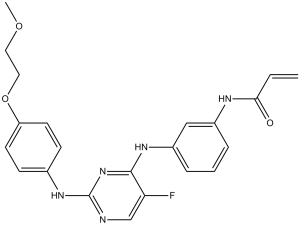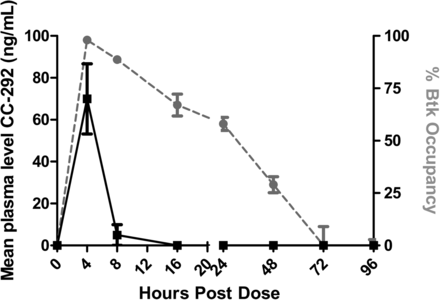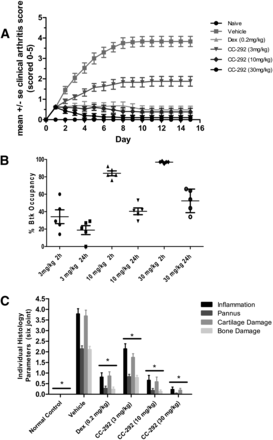This product is for research use only, not for human use. We do not sell to patients.

| Size | Price | Stock |
|---|---|---|
| 500mg | $720 | Check With Us |
| 1g | $1150 | Check With Us |
| 5g | $2900 | Check With Us |
Cat #: V0644 CAS #: 1202757-89-8 Purity ≥ 98%
Description: Spebrutinib (formerly AVL-292; CC-292; SBT) is a covalent/irreversible, orally bioactive, and highly selective inhibitor of Bruton's agammaglobulinemia tyrosine kinase/BTK inhibitor with potential antitumor activity. It inhibits BTK with an IC50 of<0.5 nM, and exhibits > 1400-fold higher selectivity for BTK over the other kinases.
Publications Citing InvivoChem Products
Product Promise

- Physicochemical and Storage Information
- Protocol
- Related Biological Data
- Stock Solution Preparation
- Quality Control Documentation
| Molecular Weight (MW) | 423.44 |
|---|---|
| Molecular Formula | C22H22FN5O3 |
| CAS No. | 1202757-89-8 |
| Storage | -20℃ for 3 years in powder formr |
| -80℃ for 2 years in solvent | |
| Solubility In Vitro | DMSO: 85 mg/mL (200.7 mM)r |
| Water: <1 mg/mLr | |
| Ethanol: <1 mg/mL | |
| Solubility In Vivo | Chemical Name: N-(3-((5-fluoro-2-((4-(2-methoxyethoxy)phenyl)amino)pyrimidin-4-yl)amino)phenyl)acrylamide InChi Key: KXBDTLQSDKGAEB-UHFFFAOYSA-N InChi Code: InChI=1S/C22H22FN5O3/c1-3-20(29)25-16-5-4-6-17(13-16)26-21-19(23)14-24-22(28-21)27-15-7-9-18(10-8-15)31-12-11-30-2/h3-10,13-14H,1,11-12H2,2H3,(H,25,29)(H2,24,26,27,28) SMILES Code: C=CC(NC1=CC=CC(NC2=NC(NC3=CC=C(OCCOC)C=C3)=NC=C2F)=C1)=O |
| SMILES Code | C=CC(NC1=CC=CC(NC2=NC(NC3=CC=C(OCCOC)C=C3)=NC=C2F)=C1)=O |
| Synonyms | Spebrutinib; CC-292; AVL292; AVL-292; CC292; CC 292; AVL 292; |
| Protocol | In Vitro | In vitro activity: AVL-292 exhibits dose-dependent inhibition of Btk with EC50 of 8 nM and downstream BCR signaling components in Ramos cells. AVL-292, by inhibiting BTK activities, further inhibits B cell proliferation with EC50 of 3 nM. Kinase Assay: The Omnia continuous read assay is performed essentially as described by the vendor. The assay conditions are: 40 μM ATP (1X KMATP), 10 μM Y5-Sox, and 10 nM BTK enzyme. Briefly, a substrate mix containing 1.13X ATP and the Y5 Sox substrate is first prepared in 1X Omnia Kinase Reaction Buffer (KRB) consisting of 20 mM Tris, pH 7.5, 5 mM MgCl2, 1 mM EGTA, 5 mMβ-glycerophosphate, 5% glycerol, and 0.2 mM DTT. For IC50 measurements, 5 μL of enzyme are incubated with serially diluted (3-fold) compounds prepared in 50% DMSO in a Corning (#3574) 384-well, white, non-binding surface microtiter plate at 25°C for 30 min. Kinase reactions are started with the addition of 45 μL of the ATP/Y5 substrate mix and monitored at λex360/λem485 in a Synergy 4 plate reader for 60 minutes. Progress curves from each well are examined for linear reaction kinetics and fit statistics. Initial velocity from each reaction is determined from the slope of a plot of relative fluorescence units versus time and then plotted against inhibitor concentration to estimate IC50 using the Response, Variable Slope model in GraphPad Prism from GraphPad Software. Cell Assay: A suspension of resting purified naïve human B cells isolated by negative selection in RPMI is prepared at 0.4–0.5 × 106 cells/ml. Cells are mixed together with α-human IgM (final concentration of 5 μg/ml in each well) and vehicle (dimethyl sulfoxide) or AVL-292 (final concentrations of 0.01, 0.1, 1.0, 10.0, 100.0, or 1000 nM per well) and seeded in a 96-well plate. Cells are incubated for 56 hours in a humidified incubator maintained at 37°C and 5% CO2. 3H-Thymidine is added (final concentration of 1 μCi in each well) and cells are incubated overnight, harvested, and measured for 3H incorporation. Experiments are performed in triplicate. |
|---|---|---|
| In Vivo | In a collagen-induced arthritis mouse model, AVL-292 (3-30 mg/kg, p.o.) dose-dependently inhibits the clinical signs of inflammatory disease, including reduction in joint and paw swelling and visible redness of the affected paws. | |
| Animal model | Collagen-induced arthritis (CIA) mouse model |
| Solvent volume to be added | Mass (the weight of a compound) | |||
|---|---|---|---|---|
| Mother liquor concentration | 1mg | 5mg | 10mg | 20mg |
| 1mM | 2.3616 mL | 11.8080 mL | 23.6161 mL | 47.2322 mL |
| 5mM | 0.4723 mL | 2.3616 mL | 4.7232 mL | 9.4464 mL |
| 10mM | 0.2362 mL | 1.1808 mL | 2.3616 mL | 4.7232 mL |
| 20mM | 0.1181 mL | 0.5904 mL | 1.1808 mL | 2.3616 mL |
This equation is commonly abbreviated as: C1 V1 = C2 V2
- (1) Please be sure that the solution is clear before the addition of next solvent. Dissolution methods like vortex, ultrasound or warming and heat may be used to aid dissolving.
- (2) Be sure to add the solvent(s) in order.






































